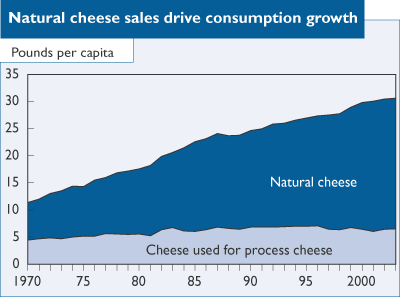Behind the Data
- by James Miller
- 2/1/2005
Measuring America's Cheese Consumption
Cheese consumption has grown in the last 50 years from a relatively minor food to a staple, with Americans averaging almost a serving per day. In the 1950s, specialty cheeses were not widely available, and Cheddar or process American cheeses were eaten plain or incorporated into a limited number of dishes. The longrun growth in cheese consumption has been driven by more cheeses being used in more dishes in more places.
Consumption of cheese, as with most storable dairy products, is estimated by relatively simple disappearance calculations. Total supply is defined as production plus beginning stocks and imports. After ending stocks, exports, and shipments to U.S. Territories are subtracted, the remainder is considered consumption. Production is estimated by USDA’s National Agricultural Statistics Service (NASS) from a survey of dairy plants. Stocks estimates are from NASS’s survey of cold-storage warehouses, augmented by information from USDA’s Farm Service Agency. International trade data come from the Bureau of Census and USDA’s Foreign Agricultural Service.
Disappearance estimates for cheese generally involve fewer interpretation problems than for many foods. Once manufactured, cheese undergoes little further processing. Combined with its traditionally high cost, this straightforward marketing flow leads to relatively minor wastage between manufacturing and the final user. For example, considerable cheese is trimmed off when rectangular blocks are cut into specialty shapes such as 'longhorns.' But this trim is used in process cheese products.
Information for a full supply and utilization calculation is not available for most individual cheeses. However, estimates are still made if the missing information is thought to have relatively little effect. For example, stocks of Muenster are included in the reported 'other natural cheese' category. However, separate data on stocks would only rarely influence consumption estimates because Muenster is stored only briefly, and changes in stocks would be dwarfed by other factors.
Cheese data record the weight of natural cheese used and whether that cheese was sold directly to consumers or used in process cheese products. The actual weight of all cheese and cheese products is larger than total cheese consumption because process cheese products include additional moisture and (possibly) other ingredients.
We’d welcome your feedback!
Would you be willing to answer a few quick questions about your experience?



